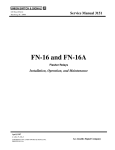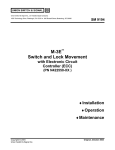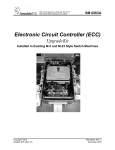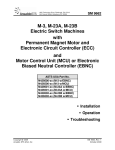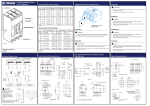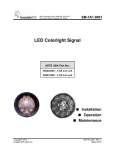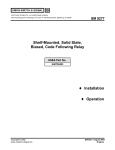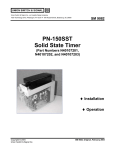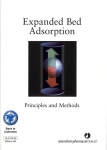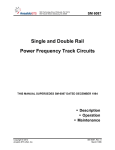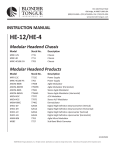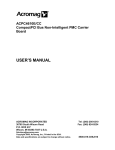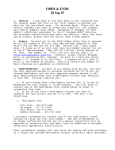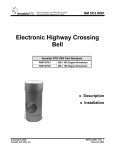Download Union Switch & Signal - Ansaldo STS | Product Support
Transcript
Union Switch & Signal Inc., an Ansaldo Signal company SM 9020 1000 Technology Drive, Pittsburgh, PA 15219 ● 645 Russell Street, Batesburg, SC 29006 , Field Test Unit (N42252601) for the Electronic Circuit Controller (ECC) Operation Copyright © 2002 Union Switch & Signal Inc. SM 9020, Rev. 0, September 2002 Proprietary Notice This document and its contents are the property of Union Switch & Signal Inc. (hereinafter US&S). This document has been furnished to you on the following conditions: no right or license under any patents or any other proprietary right in respect to this document or its content is given or waived in supplying this document. This document or its content are not to be used or treated in any manner inconsistent with the rights of US&S, or to its detriment, and are not to be copied, reproduced, disclosed to others, or disposed of except with the prior written consent of US&S. Important Notice US&S constantly strives to improve our products and keep our customers abreast of changes in technology. Based on US&S’s experience, our customers will obtain the best possible operational reliability by following the recommendations contained in the attached service manual. The data contained herein purports solely to describe the product, and it is not a warranty of performance or characteristics. Within the scope of the attached manual, it is impossible to take into account every eventuality that may arise with technical equipment in service. Please consult US&S local sales representative in the event of any irregularities with our product. We expressly decline liability for damages resulting from any improper handling or use of our equipment, even if these instructions contain no specific indication in this respect. We stress the fact that only genuine approved US&S spare parts should be used for replacements. SM 9020, Rev. 0, September 2002 i Revision History Revision History Original ii September 2002 SM 9020, Rev. 0, September 2002 Table of Contents Table of Contents Section 1 Introduction ......................................................................................................................................... 1-1 1.1 Application ................................................................................................................................... 1-1 1.2 Purpose of Manual ...................................................................................................................... 1-1 1.3 Conventions in Manual ................................................................................................................ 1-2 1.3.1 Abbreviations, Acronyms, and Definitions............................................................................ 1-2 1.4 Safety ......................................................................................................................................... 1-4 Section 2 Equipment Description...................................................................................................................... 2-1 2.1 Power Requirement..................................................................................................................... 2-1 Section 3 Functional Description ...................................................................................................................... 3-1 3.1 ECC DIAGNOSTIC INFORMATION ........................................................................................... 3-1 3.2 ECC Field Test Unit Controls ...................................................................................................... 3-2 Section 4 Installation ........................................................................................................................................... 4-1 Section 5 Operating Procedures........................................................................................................................ 5-1 5.1 ECC Diagnostic Testing .............................................................................................................. 5-1 5.2 ECC Vital/Non-Vital Sensor Testing............................................................................................ 5-5 5.2.1 Vital Sensor Test.................................................................................................................. 5-5 5.2.2 Non-Vital Sensor Test .......................................................................................................... 5-6 Section 6 Maintenance/Repair ........................................................................................................................... 6-1 Section 7 Technical Support .............................................................................................................................. 7-1 Appendix A Data Sheet ...................................................................................................................................A-1 List of Figures Figure 2-1 – Field Test Unit to ECC Connections...................................................................................... 2-2 List of Tables Table 2-1 – WAGOâ Block to ECC Field Test Unit Power Wiring ............................................................. 2-1 Table 3-1– ECC Diagnostic LED Definitions ............................................................................................. 3-1 SM 9020, Rev. 0, September 2002 Page iii Table of Contents iv !UNION SWITCH & SIGNAL!~ SM 9020, Rev. 0, September 2002 Section 1 – Introduction Section 1. Introduction This service manual describes the use and function of the Field Test Unit for the Electronic Circuit Controller (ECC) for the M23E and M23 retrofitted style switch machines. For detailed information on the installation, operation, maintenance, and adjustment of the ECC, please refer to Service Manual 6263A. For detailed information on the installation, operation, maintenance, and adjustment of the Mstyle machines, please refer to Service Manuals 6263 and 7100. The US&S Electronic Circuit Controller (ECC) is used on US&S M-3 and M-23 (A or B) style switch machines. The (ECC) uses four vital proximity sensors: two to detect the position of the switch points (normal or reverse) and two to detect that the machine is fully locked (normal or reverse). The ECC is a microprocessor-based controller that vitally monitors the state of the four vital proximity sensors and can identify each possible sensor state (on, off, shorted, or open). In addition to the four vital proximity sensors, the ECC can be equipped with an optional auxiliary point detection system. This system provides a normally ON bipolar output to warn maintenance personnel of marginal switch machine operation. The sensing threshold of each auxiliary sensor is offset from the vital point detector sensors by approximately 1/8” to detect switch point displacement before the vital sensors indicate point detector bar movement. With the auxiliary system, switch point displacement that is caused by debris build-up or expansion and contraction of the rail can be detected before a switch failure occurs. The ECC provides advanced diagnostics for identifying the current state of the machine and the indication state of an adjacent (daisy-chained) machine. LEDs on the ECC indicate the delivery of indication power and auxiliary indication power to the wayside, as well as provide information on motor power availability and the state of the latch-out function. 1.1. Application The ECC Field Test Unit is a diagnostic tool for testing an ECC while installed in a switch machine; it can also test individual proximity sensors associated with a given switch machine. WARNING 1. To avoid severe personal injury, open the gold nut test link in the motor compartment prior to performing any internal machine maintenance. 2. Always keep hands and feet clear of switch points and the internal moving parts of the machine. Ensure that loose clothing is properly secured prior to working on the switch machine. The Field Test Unit attaches to the ECC and can test the ECC to ensure it is properly operating without actually cycling the switch. While connected to the ECC, the Field Test Unit can also verify the proper operation of the sensors on that switch machine. 1.2. Purpose of Manual This service manual provides descriptive information on the use of the Field Test Unit for the US&S Electronic Circuit Controller which is installed on the M23E, M-3, and M-23 Switch Machines. The SM 9020, Rev. 0, September 2002 1-1 Section 1- Introduction Field Test Unit itself is used in the maintenance of switch machines and is intended for use as a diagnostic tool to provide feedback on the status of an ECC unit and all related proximity sensors. 1.3. Conventions in Manual 1.3.1. Abbreviations, Acronyms, and Definitions ac alternating current AAR Association of American Railroads - Communication and Signal Section (currently known as AREMA) AREA American Railway Engineering Association AREMA American Railway Engineering and Maintenance-of-Way Association (formerly known as AAR) AWG American wire gauge CAUTION Caution statements indicate conditions that could cause damage to equipment dc direct current ECC Electronic Circuit Controller Front of Machine The physical area of the switch machine furthest from the motor FRA Federal Railroad Administration Latch-Out A device that does not allow switch point indication to restore if the switch point moves away from the stock rail (point detection is momentarily lost). This function will be activated if the point sensors are actuated before their corresponding locking sensors are actuated. Latch-Out Restoration The term latch-out restoration refers to resetting the machine to an operable switch machine indication state from a latched-out condition. LED Light-emitting diode Left Hand Switch The position of a switch machine designated when the machine is located on the left-hand side of the track, looking into the switch points in the direction of the arrow as shown in Figure 1-1. LHPC “Left-hand point closed,” which refers to the switch point position when the point is normally closed to the left-hand side, looking into the switch points in the direction of the arrow as shown in Figure 1-1. Point Detection The positive indication achieved when the switch points are closed adequately against the stock rail. Locking Locking is achieved when the lock box, connected to the slide bar, enters the narrow locking notch of the lock rods and extends a minimum of 1/2” into the locking rod MCU Motor control unit - a high-current, solid-state device used to control motor power MOV Metal oxide varistor (protection device for electronic components) 1-2 SM 9020, Rev. 0, September 2002 Section 1 – Introduction LEFT- HAND RIGHT- HAND Figure 1-1- Left-Hand and Right-Hand Switch Machines Non-Vital Any circuit with a function that does not affect the safety of train operation PCB Printed circuit board Rear of Machine The physical area of the switch machine closest to the motor Reference Designator An abbreviation assigned to designate an electrical component. It generally consists of a capital letter and a number. Each letter designates a particular type of component. For example, “L” identifies an inductor and “R” identifies a resistor. Right Hand Designator The position of a switch machine designated when the machine is located on the right-hand side of the track, looking into the switch points in the direction of the arrow shown in Figure 1-1. RHPC “Right-hand point closed,” which refers to the switch point position when the point is normally closed to the right-hand side of the track, looking into the switch points in the direction of the arrow shown in Figure 1-1. RMS root-mean-square (method for expressing ac voltage rating Switch Machine Indication A vital determination of a safe switch configuration, due to positive indication that the switch machine has properly thrown, locked and detected switch point closure Switch and Lock Movement and/or Switch Machine A device which performs the three operations of unlocking, operating, and locking a switch, movable point frog, or derail US&S Union Switch & Signal Vital Circuit Any circuit with a function that affects the safety of train operation WAGO® Registered trademark for WAGO Corporation WARNING Warning statements indicate conditions that could cause physical harm, serious injury, or loss of life SM 9020, Rev. 0, September 2002 1-3 Section 1- Introduction 1.4. Safety Read and thoroughly understand this manual before attempting any of the procedures listed. Pay particular attention to the WARNING and CAUTION statements that appear throughout this manual. Always exercise care and observe standard precautions familiar to properly trained personnel. Always adhere to all safety regulations stipulated by the railroad. 1-4 SM 9020, Rev. 0, September 2002 Section 2 – Equipment Description Section 2. Equipment Description For information regarding the system functions and components related to the electronic control system inside of the switch machine refer to service manuals SM-6263A for M23 retrofit machines and SM7100 for M23E machines. The ECC Field Test Unit connects directly to the three front connectors of the ECC and does not require that the ECC be removed from a switch machine. When looking at the Field Test Unit from the top side, the three cables are connected directly to the ECC for testing without crossing them (Figure 2-1). NOTE The cables for TB1 and JB1 are keyed in the same manner. Cable lengths and cable ties should prevent cross connections; however, in the event they are incorrectly re-connected and power is applied, the ECC will appear as if no power has been applied. Because there is no power, if cross connections are made, no damage to the unit will occur. Swapping the connectors should return the ECC to normal operation if no problems were found during diagnostic testing. Connector keying will prevent any other incorrect connections. The Field Test Unit is designed to simulate the equipment that is connected to the ECC and to manipulate the states of that equipment to determine how the ECC responds. This provides fast indication as to the status of the ECC and assists in the diagnosis of any problem that may arise. 2.1. Power Requirement When connected to an ECC and power is applied to the Field Test Unit, the ECC will also be powered on. The power required for the ECC Field Test Unit is 9.8Vdc to 16.2Vdc @ 1.5A and may be brought from an independent external source or power may be fed from the WAGOâ terminal block and connected as detailed in Table 2-1. (Approximately 8 feet of 20AWG wire (minimum) is recommended for each of these connections.) Table 2-1 – WAGOâ Block to ECC Field Test Unit Power Wiring WAGOâ Terminal Block Connection ECC Field Test Unit Connection Signal Block Number 20 Red Power Terminal B12 – Battery + Block Number 16 Black Power Terminal N12 – Battery - SM 9020, Rev. 0, September 2002 2-1 Section 2- Equipment Description NORMAL REVERSE Point Detected Point Detected Point Locked Point Locked Indication Input Indication Input Indication Output Indication Output Auxiliary Point Detected Auxiliary Point Detected Latch Out Motor Disabled LED Diagnostics UNION SWITCH & SIGNAL ECC N47303401 Latch Out Restoration (Press for 1 Second and Release) TB1 JB1 TB2 BROWN BLUE BROWN BLUE VITAL SENSOR TEST NON-VITAL SENSOR TEST NONE LHPC RHPC DIRECTION DISABLE NONE MANUAL AUTO LATCHOUT Vital Sensors ON OFF POINT SENSE 1 POINT SENSE 2 LOCK SENSE 1 LOCK SENSE 2 Non-Vital Sensors ON OFF AUXILIARY SENSE 1 AUXILIARY SENSE 2 HAND THROW HAND CRANK ECC FIELD TEST UNIT UNION SWITCH & SIGNAL 645 Russell St. Batesburg, SC 29006 POWER 9.8-16.2VDC Figure 2-1 – Field Test Unit to ECC Connections 2-2 SM 9020, Rev. 0, September 2002 Section 3 – Functional Description Section 3. Functional Description 3.1. ECC DIAGNOSTIC INFORMATION The ECC is equipped with a series of LEDs to indicate the current state of the switch machine. Dualcolored LEDs are provided to indicate the state of each vital point and lock sensor. Green LEDs are provided for indication input, indication output, and auxiliary sensor state definition. Red LEDs are provided to determine when the motor is disabled and when the ECC is in a latched-out state. Table 3-1describes what the ECC diagnostics represent. Table 3-1– ECC Diagnostic LED Definitions LED Name (NORMAL or REVERSE) Point Detected State 1 / /Meaning State 2 / Meaning State 3 / Meaning GREEN Normal Point Sensor Detected RED Point Sensor Not Detected DARK ECC Malfunctioning Point Locked GREEN Normal Point Lock Sensor Detected RED Point Lock Sensor Not Detected DARK ECC Malfunctioning Indication Input GREEN Power is present to generate an Indication Output GREEN All ECC internal diagnostics complete correctly, machine state dictates that all vital sensors are in legal states, configuration jumpers are installed in legal positions, and power is present to generate the Indication Output GREEN Auxiliary Point Sensor Detected RED Machine is latched out DARK Power is not present to generate Indication Output RED Motor power is disabled DARK Motor power is enabled Indication Output Auxiliary Point Detected Latch Out Motor Disabled WARNING The GOLD Nut must be removed when performing machine maintenance SM 9020, Rev. 0, September 2002 Flashing/Meaning FLASHING RED Point Sensor in Indeterminate State, or LHPC/RHPC not selected FLASHING RED Point Lock Sensor in Indeterminate State, or LHPC/RHPC not selected FLASHING GREEN ECC Malfunctioning DARK Power is not present to generate Indication Output even if the machine state dictates, configuration jumpers not installed or multiple jumpers installed, ECC internal diagnostics failure FLASHING GREEN ECC Malfunctioning DARK Auxiliary Point Sensor Not Detected DARK Machine is not latched out FLASHING GREEN ECC Malfunctioning FLASHING RED No latchout mode selected, or multiple latchout modes selected FLASHING RED ECC internal diagnostics fail (Both Indication Input LEDs will be GREEN when using the Field Test Unit) NOTE: When using the Field Test Unit, if this state exists the ECC box has failed and needs to be replaced 3-1 Section 3- Functional Description 3.2. ECC Field Test Unit Controls The controls on the ECC Field Test Unit are comprised of eight push button switches that are illuminated GREEN when pushed in (ON state) and are illuminated RED when released (OFF state). These buttons represent the eight possible sensors that can be installed in an M23E or M23 retrofit switch machine and simulate the LEDs on the ECC. Some configurations of switch machines do not include all of the non-vital sensors, but the ECC does not distinguish this fact. It does not illuminate the auxiliary sensor LEDs if they are not installed. The hand crank and hand throw sensors are simulated on the WAGOâ terminal block by a resistor such that the ECC still reads a return current as if they were installed. So regardless of the machine’s configuration, the ECC can still be tested using the Field Test Unit as described below. Two rotary switches simulate the jumper configurations that are contained in the junction box. The DIRECTION rotary switch tells the ECC if the switch is configured as Left Hand Points Closed (LHPC) or Right Hand Points Closed (RHPC). The LATCHOUT rotary switch tells the ECC how to respond to a latchout situation that can be simulated by the Field Test Unit. Both of these rotary switches provide a NONE position to simulate no jumper being installed in the junction box for that function. The ECC should respond correctly to that condition as well. The two momentary push buttons at the top of the Field Test Unit are used to switch a vital or non-vital sensor into the circuit for testing. 3-2 SM 9020, Rev. 0, September 2002 Section 4 – Installation Section 4. Installation Installation of the Field Test Unit is accomplished by removing the three cables connected to the ECC and connecting the corresponding cables from the Test Unit to the ECC. Power is applied as described in Section 2.1. No other connections are required. The ECC under test does not need to be removed from the machine. WARNING 1. To avoid severe personal injury, open the gold nut test link in the motor compartment prior to performing any internal machine maintenance. 2. Always keep hands and feet clear of switch points and the internal moving parts of the machine. Ensure that loose clothing is properly secured prior to working on the switch machine. CAUTION When reconnecting the machine cables, ensure the collars are turned until they lock. Additionally, if power is fed from the WAGOâ terminal block, carefully remove the wires without disturbing other connections. If other connections are disturbed, removed, cut, or otherwise disconnected, then breakdown or other types of testing may be required to be performed again. NOTE The cables for TB1 and JB1 are keyed in the same manner. Cable lengths and cable ties should prevent cross connections; however, in the event they are incorrectly re-connected and power is applied, the ECC will appear as if no power has been applied. If cross connections are made, no damage to the unit will occur. Swapping the connectors should return the ECC to normal operation if no problems were found during diagnostic testing. Connector keying will prevent any other incorrect connections. SM 9020, Rev. 0, September 2002 4-1 Section 4- Installation 4-2 !UNION SWITCH & SIGNAL!~ SM 9020, Rev. 0, September 2002 Section 5 – Operating Procedures Section 5. Operating Procedures The ECC Field Test Unit may be used to fully gauge the performance of an ECC unit by connecting it to the ECC as shown in Figure 2-1. It may also test individual vital and non-vital sensors used in a switch machine. NOTE The sensors used for both Auxiliary Point Detection sensors and for both the Hand Crank and Hand Throw functions are all electrically identical and are all considered “non-vital” types. They may vary in barrel length. The following procedure verifies the correct performance of an ECC and/or any of the proximity sensors. Record the results of the procedure on the Data Sheet supplied in Appendix A. 5.1. ECC Diagnostic Testing 1. After power up, set switches on the Field Test Unit as follows: DIRECTION = LHPC LATCHOUT = DISABLE POINT SENSE 1 = ON (GREEN) POINT SENSE 2 = OFF (RED) LOCK SENSE 1= ON (GREEN) LOCK SENSE 2 = OFF (RED) AUXILIARY SENSE 1 = ON (GREEN) AUXILIARY SENSE 2 = OFF (RED) HAND THROW = ON (GREEN) HAND CRANK = ON (GREEN) 2. Verify that the LEDs on the ECC controller appear as follows: NORMAL REVERSE POINT DETECTED = GREEN POINT DETECTED = RED LOCK DETECTED = GREEN LOCK DETECTED = RED INDICATION INPUT = GREEN INDICATION INPUT = GREEN INDICATION OUTPUT = GREEN INDICATION OUTPUT = DARK AUXILIARY POINT DETECTED = GREEN AUXILIARY POINT DETECTED = DARK LATCHOUT = DARK MOTOR DISABLED = DARK 3. Move the DIRECTION switch on the Field Test Unit to the RHPC position. Verify that the LEDs on the ECC controller appear as follows: SM 9020, Rev. 0, September 2002 5-1 Section 5 – Operating Procedures NORMAL REVERSE POINT DETECTED = RED POINT DETECTED = GREEN LOCK DETECTED = RED LOCK DETECTED = GREEN INDICATION INPUT = GREEN INDICATION INPUT = GREEN INDICATION OUTPUT = DARK INDICATION OUTPUT = GREEN AUXILIARY POINT DETECTED = DARK AUXILIARY POINT DETECTED = GREEN LATCHOUT = DARK MOTOR DISABLED = DARK 4. Move the DIRECTION switch on the Field Test Unit to the NONE position. Verify that the LEDs on the ECC controller appear as follows: NORMAL REVERSE POINT DETECTED = BLINK RED POINT DETECTED = BLINK RED LOCK DETECTED = BLINK RED LOCK DETECTED = BLINK RED INDICATION INPUT = GREEN INDICATION INPUT = GREEN INDICATION OUTPUT = DARK INDICATION OUTPUT = DARK AUXILIARY POINT DETECTED = DARK AUXILIARY POINT DETECTED = DARK LATCHOUT = DARK MOTOR DISABLED = RED 5. Move the DIRECTION switch on the Field Test Unit to the LHPC position. Set the POINT SENSE 1 push button switch on the Field Test Unit to OFF or RED. Verify that the LEDs on the ECC controller appear as follows: NORMAL REVERSE POINT DETECTED = RED POINT DETECTED = RED LOCK DETECTED = GREEN LOCK DETECTED = RED INDICATION INPUT = GREEN INDICATION INPUT = GREEN INDICATION OUTPUT = DARK INDICATION OUTPUT = DARK AUXILIARY POINT DETECTED = GREEN AUXILIARY POINT DETECTED = DARK LATCHOUT = RED MOTOR DISABLED = DARK 6. Set the POINT SENSE 1 push button switch on the Field Test Unit to ON or GREEN and verify the LEDs on the ECC controller return to the configuration of Step 2. 7. Move the LATCHOUT switch on the Field Test Unit to the MANUAL position. Set the POINT SENSE 1 push button switch on the Field Test Unit to OFF or RED. Verify that the LEDs on the ECC controller appear as follows: 5-2 SM 9020, Rev. 0, September 2002 Section 5 – Operating Procedures NORMAL REVERSE POINT DETECTED = RED POINT DETECTED = RED LOCK DETECTED = GREEN LOCK DETECTED = RED INDICATION INPUT = GREEN INDICATION INPUT = GREEN INDICATION OUTPUT = DARK INDICATION OUTPUT = DARK AUXILIARY POINT DETECTED = GREEN AUXILIARY POINT DETECTED = DARK LATCHOUT = RED MOTOR DISABLED = DARK 8. Set the POINT SENSE 1 push button switch on the Field Test Unit to ON or GREEN, push the Latchout Restore button on the ECC Controller for a minimum of 1 second and verify the LEDs on the ECC controller return to the configuration of Step 2. 9. Move the LATCHOUT push button switch to the AUTO position. Set the POINT SENSE 1 push button switch to OFF or RED. Verify that the LEDs on the ECC controller appear as follows: NORMAL REVERSE POINT DETECTED = RED POINT DETECTED = RED LOCK DETECTED = GREEN LOCK DETECTED = RED INDICATION INPUT = GREEN INDICATION INPUT = GREEN INDICATION OUTPUT = DARK INDICATION OUTPUT = DARK AUXILIARY POINT DETECTED = GREEN AUXILIARY POINT DETECTEDE= DARK LATCHOUT = RED MOTOR DISABLED = DARK 10. Set the LOCK SENSE 1 push button switch to OFF or RED, then set the POINT SENSE 1 push button switch back to ON or GREEN, and then set the LOCK SENSE 1 push button switch back to ON or GREEN. Verify the LEDs on the ECC controller return to the configuration of Step 2 above. 11. Move the LATCHOUT switch to the NONE position. Verify that the LEDs on the ECC controller appear as follows: NORMAL REVERSE POINT DETECTED = GREEN POINT DETECTED = RED LOCK DETECTED = GREEN LOCK DETECTED = RED INDICATION INPUT = GREEN INDICATION INPUT = GREEN INDICATION OUTPUT = DARK INDICATION OUTPUT = DARK AUXILIARY POINT DETECTED = GREEN AUXILIARY POINT DETECTED = DARK LATCHOUT = BLINK RED MOTOR DISABLED = RED SM 9020, Rev. 0, September 2002 5-3 Section 5 – Operating Procedures 12. Move the LATCHOUT switch to the MANUAL position. Set the AUXILIARY SENSE 1 push button switch to OFF. Verify that the LEDs on the ECC controller appear as follows: NORMAL REVERSE POINT DETECTED = GREEN POINT DETECTED = RED LOCK DETECTED = GREEN LOCK DETECTED = RED INDICATION INPUT = GREEN INDICATION INPUT = GREEN INDICATION OUTPUT = GREEN INDICATION OUTPUT = DARK AUXILIARY POINT DETECTED = DARK AUXILIARY POINT DETECTED = DARK LATCHOUT = DARK MOTOR DISABLED = DARK 13. Reset the AUXILIARY SENSE 1 push button switch to ON. Set the AUXILIARY SENSE 2 push button switch to ON. Verify that the LEDs on the ECC controller appear as follows: NORMAL REVERSE POINT DETECTED = GREEN POINT DETECTED = RED LOCK DETECTED = GREEN LOCK DETECTED = RED INDICATION INPUT = GREEN INDICATION INPUT = GREEN INDICATION OUTPUT = GREEN INDICATION OUTPUT = DARK AUXILIARY POINT DETECTED = GREEN AUXILIARY POINT DETECTED = GREEN LATCHOUT = DARK MOTOR DISABLED = DARK 14. Reset the AUXILIARY SENSE 2 push button switch to OFF. Set the HAND THROW push button switch to OFF. Verify that the LEDs on the ECC controller appear as follows: NORMAL REVERSE POINT DETECTED = GREEN POINT DETECTED = RED LOCK DETECTED = GREEN LOCK DETECTED = RED INDICATION INPUT = GREEN INDICATION INPUT = GREEN INDICATION OUTPUT = DARK INDICATION OUTPUT = DARK AUXILIARY POINT DETECTED = GREEN AUXILIARY POINT DETECTED = DARK LATCHOUT = DARK MOTOR DISABLED = RED 15. Set the HAND THROW push button switch to ON. Set the HAND CRANK push button switch to OFF. Verify that the LEDs on the ECC controller appear as follows: 5-4 SM 9020, Rev. 0, September 2002 Section 5 – Operating Procedures NORMAL REVERSE POINT DETECTED = GREEN POINT DETECTED = RED LOCK DETECTED = GREEN LOCK DETECTED = RED INDICATION INPUT = GREEN INDICATION INPUT = GREEN INDICATION OUTPUT = DARK INDICATION OUTPUT = DARK AUXILIARY POINT DETECTED = GREEN AUXILIARY POINT DETECTED = DARK LATCHOUT = DARK MOTOR DISABLED = RED 16. Set the HAND CRANK push button switch to ON. Set the HAND CRANK and HAND THROW push button switches to OFF. Verify that the LEDs on the ECC controller appear as follows: NORMAL REVERSE POINT DETECTED = GREEN POINT DETECTED = RED LOCK DETECTED = GREEN LOCK DETECTED = RED INDICATION INPUT = GREEN INDICATION INPUT = GREEN INDICATION OUTPUT = DARK INDICATION OUTPUT = DARK AUXILIARY POINT DETECTED = GREEN AUXILIARY POINT DETECTED = DARK LATCHOUT = DARK MOTOR DISABLED = RED 17. Set the HAND CRANK and HAND THROW push button switches to ON. Verify the LEDs on the ECC appear as in Step 2. If the ECC responded correctly, the ECC is operating properly and should not be causing any problems. In this case, any operating problem is due to the switch machine itself. Refer to the switch machine manual for troubleshooting procedures. If the ECC did not respond as it should have during the test, there is a problem with the ECC. Because there are no field or shop maintenance procedures for the ECC, US&S recommends that the ECC be replaced and the unit be returned to the US&S Batesburg location for repair. 5.2. ECC Vital/Non-Vital Sensor Testing To test a vital or non-vital sensor, connect the Field Test Unit to an ECC per Section 4. Press down on the black quick-connect terminals at the top of the unit for the type of sensor to be tested (VITAL SENSOR TEST or NON-VITAL SENSOR TEST). Insert the two sensor wires per the color indicated on the Field Test Unit label. See Figure 2-1. 5.2.1. Vital Sensor Test Initially when the sensor is connected it is not “in-circuit” for the ECC to be able to test. Press and hold the momentary push button below the terminals labeled VITAL SENSOR TEST while implementing all test steps. SM 9020, Rev. 0, September 2002 5-5 Section 5 – Operating Procedures Step 1: If the sensor is not near a metallic or conductive surface (more than 1.2mm), the LED that corresponds to Point Detected on the NORMAL side of the ECC will be steady RED indicating the sensor is OFF or is not sensing a target. Step 2: Move the sensor near a metallic or conductive surface (less than 1.2mm). The LED that corresponds to Point Detected on the NORMAL side of the ECC will be steady GREEN indicating the sensor is in ON or is sensing a target. Step 3: (Optional) Under normal circumstances the sensor is either ON or OFF. However, careful placement of the sensor near a metallic or conductive surface (more than 1.2mm but less than 4mm) may result in the Point Detected LED flashing RED indicating the sensor is in the indeterminate state between ON and OFF. This may be difficult to achieve. If the NORMAL side Point Detected LED is flashing RED, steady RED, or steady GREEN regardless of sensor position, the sensor is not functioning properly. Additionally, if the NORMAL side Point Detected LED does not function, as indicated in Steps 1 and 2, the sensor is not functioning properly. 5.2.2. Non-Vital Sensor Test Initially when the sensor is connected, it is not “in-circuit” for the ECC to be able to test. Press and hold the momentary push button below the terminals labeled “NON-VITAL SENSOR TEST” while implementing the test. Step 1: If the sensor is not near a metallic or conductive surface (more than 1mm), the LED that corresponds to Auxiliary Point Detected on the NORMAL side of the ECC will be DARK indicating the sensor is OFF or is not sensing a target. Step 2: Move the sensor near a metallic or conductive surface (less than 1mm). The LED that corresponds to Auxiliary Point Detected on the NORMAL side of the ECC will be steady GREEN indicating the sensor is ON or is sensing a target. If the NORMAL side Auxiliary Point Detected LED is flashing GREEN, the ECC is not functioning properly. If the NORMAL side Auxiliary Point Detected LED is steady GREEN or DARK regardless of sensor position, the sensor is not functioning properly. Additionally, if the NORMAL side Auxiliary Point Detected LED does not function, as indicated in Steps 1 and 2, the sensor is not functioning properly. If the sensor is not functioning properly, change the sensor. Repeat the test to verify proper operation of the sensor before replacing it in the switch machine. 5-6 SM 9020, Rev. 0, September 2002 Section 6 – Maintenance / Repair Section 6. Maintenance/Repair There are no maintenance or repair procedures that field or shop personnel can perform on the Field Test Unit. If there are any problems with the Field Test Unit, US&S recommends that the Unit be returned to the US&S Batesburg location for repair. Proper operation of the Field Test Unit may be verified by performing the tests in Section 5 using an ECC and vital/non-vital sensors that are known to be properly functioning. SM 9020, Rev. 0, September 2002 6-1 Section 6 – Maintenance / Repair 6-2 !UNION SWITCH & SIGNAL!~ SM 9020, Rev. 0, September 2002 Appendix 7 – Technical Support Section 7. Technical Support The Rapid Action Information Link Team (RAIL Team) is a group of experienced product and application engineers ready to assist you to resolve any technical issues concerning this product. Contact the RAIL Team at 1-800-652-7276 or by e-mail at [email protected]. SM 9020, Rev. 0, September 2002 7-1 Appendix A – Data Sheet 7-2 !UNION SWITCH & SIGNAL!~ SM 9020, Rev. 0, September 2002 Appendix A – Data Sheet Appendix A Data Sheet SM 9020, Rev. 0, September 2002 A-1 Appendix A – Data Sheet A-2 !UNION SWITCH & SIGNAL!~ SM 9020, Rev. 0, September 2002 Appendix A – Data Sheet Test Data Sheet for Testing the ECC Using the Field Test Unit (N42252601) ECC Serial Number: _____________________________________________________ Test Unit Serial Number: _________________________________________________ Technician’s Name: _____________________________________________________ Date: _________________________________________________________________ Note In completing this form, please circle PASS or FAIL to indicate if the step has Passed or Failed. Do not use check marks or try to mark out a result. Merely circle the appropriate response. ECC Diagnostic Test – (Refer to Section 5.1 for the test procedure.) Section 5.1 Step No. Switch /Position LEDs Appear as Required 1 Initial Switch Set UP As stated in Step 1 2 Initial Switch Set Up PASS / FAIL 3 DIRECTION switch in RHPC position PASS / FAIL 4 DIRCTION switch in NONE position PASS / FAIL 5 DIRECTION switch in LHPC position POINT SENSE 1 pushbutton in OFF position PASS / FAIL 6 POINT SENSE 1 pushbutton in ON position PASS / FAIL 7 LATCHOUT switch in MANUAL position POINT SENSE 1 pushbutton in OFF position PASS / FAIL 8 POINT SENSE 1 pushbutton in ON position PASS / FAIL 9 LATCHOUT switch in AUTO position POINT SENSE 1 pushbutton in OFF position PASS / FAIL 10 LOCK SENSE 1 pushbutton in OFF position POINT SENSE 1 pushbutton in ON position Then LOCK SENSE 1 pushbutton in ON position PASS / FAIL 11 LATCHOUT switch in NONE position PASS / FAIL 12 LATCHOUT switch in MANUAL position AUXILIARY SENSE 1 pushbutton in OFF position PASS / FAIL 13 AUXILIARY SENSE 1 pushbutton in ON position AUXILIARY SENSE 2 pushbutton in ON position PASS / FAIL SM 9020, Rev. 0, September 2002 A-3 Appendix A – Data Sheet Section 5.1 Step No. Switch /Position LEDs Appear as Required 14 AUXILIARY SENSE 2 pushbutton in OFF position HAND THROW switch in OFF position PASS / FAIL 15 HAND THROW switch in ON position HAND CRANK switch in OFF position PASS / FAIL 16 HAND CRANK switch in ON position HAND THROW switch in OFF position Then HAND CRANK switch in OFF position PASS / FAIL 17 HAND CRANK switch in ON position HAND THROW switch in ON position PASS / FAIL ECC Operating Properly PASS / FAIL Technician: _________________________________ DATE: _________________ Vital Sensor Test – (Refer to Section 5.2.1 for the test procedure.) Section 5.2.1 Step No. Sensor Position LEDs Appear as Required 1 Sensor NOT NEAR metallic or conductive surface PASS / FAIL 2 Sensor NEAR metallic or conductive surface PASS / FAIL Sensor > 1.2 mm but <4mm from metallic or conductive surface PASS / FAIL 3 (Optional) Vital Sensor Operating Properly PASS / FAIL Technician: _________________________________ DATE: _________________ Non-Vital Sensor Test – (Refer to Section 5.2.2 for the test procedure.) Section 5.2.2 Step No. Sensor Position LEDs Appear as Required 1 Sensor NOT NEAR metallic or conductive surface PASS / FAIL 2 Sensor NEAR metallic or conductive surface PASS / FAIL Vital Sensor Operating Properly PASS / FAIL Technician: _________________________________ DATE: _________________ A-4 SM 9020, Rev. 0, September 2002






























